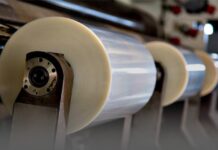Mumbai-based packaging major TCPL Packaging’s flexible packaging business is expected to end the FY2024-25 on a strong note notching up double-digit topline growth, Vidur Kanoria, executive director at TCPL Packaging told Packaging South Asia. He manages the flexible packaging and export operations at the company. Kanoria added that given the pace of growth in the flexible packaging business, the company may add its fourth printing line in FY26-27.
Despite a sluggish domestic market, TCPL Packaging’s flexible packaging business has performed well and is set to grow by approximately 25% in FY25. “Our export and flexible packaging growth has made a significant contribution to the overall topline performance of the company,” Kanoria said.
India’s cost competitiveness has played a crucial role in boosting exports, with international markets opening up, especially in Africa and the US. TCPL Packaging has capitalized on this trend by adding new customers across these regions, underscoring the long-term potential of the export business. TCPL’s flexible packaging business, in its ninth year, has grown quickly with the trend set to continue.
Continuous capacity expansion
TCPL expanded its production capacity with a third gravure printing line, which became operational in early 2024, increasing capacity to 1,500-1,600 tons per month. It currently operates three Bobst rotogravure presses with the 10-color 350 meters a minute second press added in mid-2022. The 1300 mm width press has a movable turner bar and can be run in 8+2 and 9+1 color configurations. It contains TAPS – Bobst’s total automatic pre-register system with register settings for the entire press done with a single button without any other operator intervention.
The third gravure press is an 8-color with similar features and automation but with a higher speed of 450 meters a minute. TCPL decided to bring in the third line within a few months of installing the second Bobst press. “We have already filled 70-75% of our overall capacity and are considering further expansion. By FY27, we anticipate adding a fourth printing line,” Kanoria revealed.

The company is also making significant investments in pouching technology, having recently added a fourth pouching machine to meet rising demand. Looking ahead, TCPL is eyeing entry into the liquid pouch segment for liquid detergents and fruit juices. “Preformed pouches for various applications are growing for us, and we see strong potential in this area. It also allows for more flexibility in using sustainable packaging structures such as those including MDO-PE or paper, which are much easier to run on pouching lines than on typical FFS lines,” he said.
TCPL Packaging is also boosting its R&D and sales resources, “We are strengthening our sales and R&D teams to launch new products and enter untapped customer segments. Due to the rising costs of electricity, labor, and general expenses, continuous growth is essential in India. We need to keep developing new products,” Kanoria added.
Sustainability remains a key focus for innovation
Sustainability remains a key focus for TCPL Packaging, which has been investing in recyclable and compostable packaging solutions, including home-compostable paper cups and barrier-coated paper-based laminates. “Our biggest raw material is paper, and we are ahead of the curve in developing sustainable alternatives. We’ve also made significant strides in metalized carton packaging to replace polyester film and in MDO-PE (Machine Direction Oriented Polyethylene) film development,” Kanoria highlighted.
However, the adoption of recyclable packaging in India remains slow due to the lack of regulatory pressure. “Unlike global markets, Indian brand owners have no government mandate to switch to recyclable packaging. Only multinational corporations are driving change due to global commitments. This limits domestic demand for MDO-PE, most of which is currently exported,” he said. “We not only print on MDO-PE films but also export the base film.”
Industry outlook for FY26
Looking ahead, Kanoria anticipates a better performance for the flexible packaging industry in FY26, with volume growth projected at 7-8%, and potentially reaching double digits depending on macroeconomic stability and government policies. “While consumption was weaker than expected in the past year, we do see that growth has picked up in December and January and we remain optimistic that this will continue in 2025,” he said.
Policy and industry challenges
The implementation of India’s recycled content regulations in March 2026 will be a critical milestone for the industry. However, there is a lack of clarity on compliance requirements, particularly for food packaging. “Very few customers are actively discussing recycled content inclusion, which indicates a slow transition. More regulatory clarity and availability of PCR material (other than PET) is needed to facilitate industry-wide compliance,” Kanoria emphasizes.










